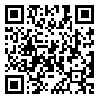BibTeX | RIS | EndNote | Medlars | ProCite | Reference Manager | RefWorks
Send citation to:
URL: http://salmandj.uswr.ac.ir/article-1-438-en.html

 , Abolghasem Pour Reza *1
, Abolghasem Pour Reza *1 
 , Abbas Rahimi Foroushani
, Abbas Rahimi Foroushani 
 , Batoul Ahmadi
, Batoul Ahmadi 
 , Ahmad Ali Akbari Kamrani
, Ahmad Ali Akbari Kamrani 

Objectives: Studies demonstrate that chronic diseases are more frequent among the elderly than other age groups. Therefore, it is reasonable to assume that more pharmaceuticals are consumed by this age group than by others and that older patients are more prone to pharmaceutical side effects and complications due to such higher drug consumption rates. Changes in pharmacokinetics and pharmacodynamics, among others, are considered as major causes of medication related complications among the elderly. Another factor worth noting is the inappropriate choice of medications prescribed for such patients, who can benefit from the identification of such medications and better care in their prescription. These issues are among the well known factors discussed in recent and relevant literature and may inflict significant harm on the health and well-being of the elderly population.
Methods & Materials: For the purpose of the present study 212 patients aged 60yr and over (mean age: 69.32 yr) discharged from 4 (2 teaching and 2 non-teaching) general hospitals affiliated with TUMS were selected. The Beers Criteria was employed to assess inappropriate use of pharmaceuticals by the sample population.
Results: Findings reveal that there was a significant relation between the level of income and the inappropriate use of medications among the sample population (P=0.041). The most frequent inappropriate use of medications, in order of frequency, included alprazolam (16.66%), chlordiazepoxide (14.28%), fluoxetine (11.90%), and oxazepam (11.90%). The highest rate of drug interactions was observed for the drug clopidogrel (29.4%). Benzodiazepines were recognized as the most frequent class of pharmaceuticals consumed by the patients (49.98%). There was no significant relationship between income rates and the amount of inappropriate drug use (P=0.041).
Conclusion: Inappropriate consumption of pharmaceuticals was relatively high among the study population, in comparison to similar consumptions in other countries. Benzodiazepines were recognized as the most frequent drugs used inappropriately by the sample population. Such a behavior may position the elderly to unpredicted and unwanted side effects resulting from drug interactions. Training physicians and medical students in this respect is recommended.
Received: 2011/06/20 | Accepted: 2011/08/25 | Published: 2011/10/01
| Rights and permissions | |
 |
This work is licensed under a Creative Commons Attribution-NonCommercial 4.0 International License. |



